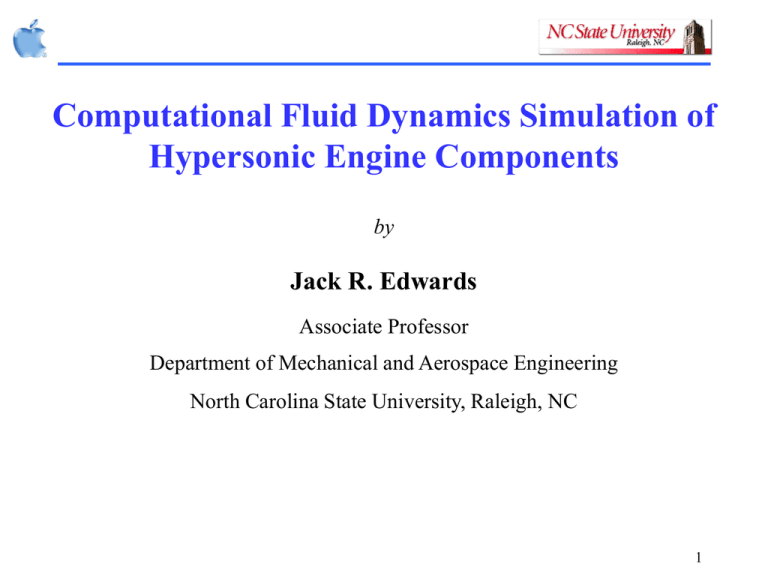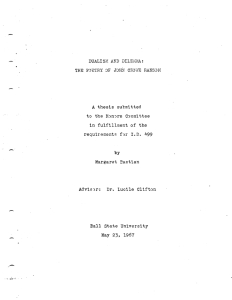Computational Fluid Dynamics Simulation of Hypersonic Engine
advertisement

Computational Fluid Dynamics Simulation of Hypersonic Engine Components by Jack R. Edwards Associate Professor Department of Mechanical and Aerospace Engineering North Carolina State University, Raleigh, NC 1 Overview Computational fluid dynamics simulation of hypersonic engine components – a major research thrust area in Aerospace Engineering at NCSU since the Mid 1980s. Current areas of emphasis: • Nose-to-tail simulations of complete engine flowfields (NASA Glenn; Edwards and McRae) • Modeling of turbulent Schmidt number and Prandtl number effects in supersonic combustion (NASA Langley; Hassan and Edwards) • Modeling of supercritical-fluid and barbotage injection of hydrocarbon fuels (AFRL/PRA; Edwards) • Algorithmic enhancements to NASA’s VULCAN flow solver (NASA Langley; Edwards and McRae) • Hybrid large-eddy / Reynolds-averaged modeling of scramjet component flowfields (NIA Seed Grant; Edwards) 2 Personnel Dr. Jack R. Edwards, Associate Professor • CFD algorithm development for reacting / multi-phase flows Dr. Hassan A. Hassan, Professor • Transition and Turbulence Modeling Dr. D. Scott McRae, Professor • Solution Adaptive Gridding Methods Jason Norris, Keith McDaniel, Ming Tian: Ph.D. students Ana Pinto, Michael Schoen: M.S. students Adam Amar: Undergraduate research assistant 3 Unique Contributions Low-Diffusion Flux-Splitting Schemes (LDFSS) • • • High-resolution upwind-differencing methods Extensions for real fluids, gas-solid flows, multi-phase mixture flows, chemically reacting flows, etc Several parallel, multi-block, implicit flow solvers built around LDFSS techniques k- Transition / Turbulence Models • • • Coordinate-invariant two-equation model for wall-bounded and free-shear flows at all speeds Transition model accounts for Tollmein-Schlicting, crossflow, bypass, and second-mode disturbance growth Predicts onset and extent of transition and has been coupled with the Spalart-Allmaras and the k- model 4 Unique Contributions Dynamic Solution-Adaptive Gridding Techniques • • • Improved feature resolution through point-clustering Extensions for time-accurate flows, multi-block grids with noncontiguous interfaces, unstructured grids Recent applications to high-speed inlet unstart and pollutant source tracking in air-quality models Hybrid Large-Eddy / Reynolds-Averaged (LES/RANS) Simulation methods • • • Techniques combine RANS strategies near solid surfaces with LES strategies further away Transition facilitated by flow-dependent blending functions Applications to shock / boundary layer interactions in internal flows 5 Resources NCSC IBM SP-2 (720 processors, 1 teraflop; soon to be replaced with a linux Beowulf cluster) 4-processor Compaq ES-40 2-processor Microway DS-20 1-processor Compaq XP-1000 Several Sun, SGI workstations Several PCs LaTEX, Tecplot, Ensight, animation software VULCAN (NASA Langley), CHEM3D (Dow Chemical) REACTMB variants (NCSU) All codes parallelizable with MPI message-passing 6 High-Speed Propulsion Time-dependent simulations of Scramjet inlet / isolator / combustor interactions Nose-to-tail simulations of NASA Glenn’s GTX RocketBased Combined-Cycle engine concept Addition of time-derivative preconditioning and parallel implicit schemes to NASA’s VULCAN flow solver Simulation of injection of supercritical fuels Simulation of aerated-liquid injection of hydrocarbon fuels (Barbotage) 7 Independent Ramjet Stream Cycle in RBCC Engines Fuel injection and premixing Flame Front Thermal Throat Rocket exhaust Injectors add fuel to the incoming air. Mixing in ramjet stream precedes ignition. Thermal throat is present. Location of thermal throat can be modulated by variations in fuel injection. 8 Rocket-Based Combined-Cycle Simulations 9 Rocket-Based Combined-Cycle Simulations 10 Rocket-Based Combined-Cycle Simulations: Rocket-shutoff with Nitrogen Purge 11 Aerated-liquid (Barbotage) injection experiments The Air Force Research Lab (AFRL) aerated-liquid injector is schematically illustrated in Fig. 01; Rectangular configuration with a dimension of 6.4 mm x 2.0 mm; A square cross section with dimension, D, of 2.0 mm used for the final discharge passage, L/D=20, converging angle θ=50°; Water as the test liquid, and nitrogen as the aerating gas. Fig. 01, Schematic of the injector assembly and internal flow structure 12 Volume fraction contours (GLR = 0.08%) Bernoulli inflow B.C. for the liquid phase 13 GLR=2.45% Photos and simulations 14 Hybrid LES/RANS Simulation Techniques General approach: unsteady RANS (Reynolds-Averaged Navier- Stokes) near solid surfaces – LES (large-eddy simulation) in outer part of the boundary layer and in free-shear layers Transition between RANS / LES based on flow-dependent blending functions based on ratios of turbulence length scales – best results when transition occurs in outer part of log layer RANS models: k- and Menter’s k- LES subgrid model: Yoshizawa’s one-equation SGS model Applications to cavity flameholder configurations, flow behind projectiles, shock / boundary layer interactions 15 Hybrid LES/RANS Simulation Techniques Instantaneous axial velocity (25 degree compression / expansion corner) 16 Hybrid LES/RANS Simulation Techniques EXP Hybrid (k-, F=F3, fine grid) Hybrid (k-, F=F3, coarse grid) RANS (k-) 5 4.5 4 0.6 x' = 1.25 cm 3.5 pw/p Exp Hybrid (k-, F=F3, fine grid) Hybrid (k-, F=F3, coarse grid) RANS (k-) 2.35 cm 3.10 cm 0.5 3 0.4 y', cm 2.5 2 1.5 0.2 1 0.5 0.3 0.1 -5 0 5 x', cm Wall pressure distributions (25 degree compression/ expansion corner) 00 1 1 1 u/ue Velocity profiles in recovery region (25 degree compression / expansion corner) 17 NIA-Sponsored Work Primary Goal: to extend earlier work in hybrid LES/RANS simulations to three-dimensional flows characteristic of dual-mode scramjet engines Year 1 accomplishments • Addition of generalized multi-block capability to hybrid LES/RANS solver • Addition of full reactive-flow capability • Development of better blending functions to shift modeling from unsteady RANS to LES Test cases underway: • Investigation of separation-shock unsteadiness in compression-corner interactions • Simulation of reactive flow downstream of UVA single-ramp, dualmode injector using hybrid LES/RANS 18 NIA-Sponsored Work: Separation-Shock Unsteadiness Prediction of response of turbulent boundary layer to shock interaction (representative of high-speed flows within inlet / isolator configurations) Large-scale, low-frequency unsteadiness of regions of shock-separated flow observed in experiments Can hybrid LES/RANS methods predict this type of unsteadiness? 19 NIA-Sponsored Work: Separation-Shock Unsteadiness Time-dependent surface pressure contours 20 NIA-Sponsored Work: Separation-Shock Unsteadiness Average surface pressure distributions PDF of separation-shock position 21 Leveraging NIA-Sponsored Work “Hybrid LES/RANS Simulations of Complex Internal Flows with Multiple Shock / Boundary Layer Interactions” Edwards and Hassan; AFOSR; pending “Database and Model Development for Combined-Cycle Mode Transition” McDaniel, Cresci, Edwards, Goyne, O’Brian, Riggins, Schetz; NASA NGLTP; pending (submitted by NIA) MURI White Paper on Combined Cycle Engines, Frankel, Edwards, McDaniel, Goyne, Hanson, Sung, Dutton, Loth; AFOSR; pending 22 Challenges Demise of North Carolina Supercomputing Center (July 1, 2003) – loss of 720 processor IBM SP-3 Mitigation strategies: • • • • 32 processor IBM P690 (NCSU) 32 processor IBM Bladecenter (NCSU) 128 processor IBM Bladecenter (NCSU; under construction; expandable) Access to 1024 processor IBM SP-3 at Oak Ridge National Laboratories 23 Simulation of a time-dependent coatings process 24 Pollutant Capture in Circulating Fluidized Beds Three-phase system: two solids phases, one multi- component gas phase Sub-models for fine particulate matter agglomeration, sulfur dioxide sorption, mercury capture onto activated carbon High-resolution LDFSS extension for separated gas-solid flows 25 Solids voidage time evolution 26 Fine PM number density time evolution 27 Fine PM flow rates 28 Supercavitating water flow about a projectile 29 New Directions Atmospheric turbulence modeling and solution-adaptive meteorological simulations Level-set methods and immersed-boundary algorithms • Human-induced contaminant transport • Diesel engine injector simulations • Two-phase bubble dynamics Hybrid LES/RANS simulations of • Shock-train propagation • Ramped-injector flowfields • Biological systems (lung bronchii, aortic aneurisms) 30 Level-Set / Immersed Boundary Methods: 2-D Simulation of “feet” moving in a box filled with air 31







